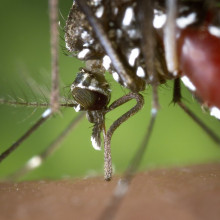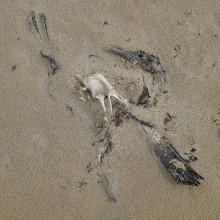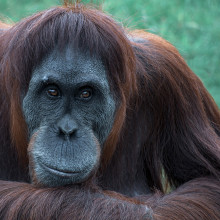In the news pod, as an outbreak of Dengue fever rips through Brazil, we ask, should we be worried in Europe? Also, scientists describe the microbes responsible for the decomposition of animal flesh, and a miraculous underwater archaelogical find sheds light on ancient hunting practices. Plus, could teasing behaviours in great apes be the origins of our own sense of humour?
In this episode

00:57 - Dengue fever outbreak grips Brazil
Dengue fever outbreak grips Brazil
James Whitehorn, Guy's and St Thomas' NHS Foundation Trust
Brazil is in the midst of a huge outbreak of dengue fever, with public health experts anticipating a surge in cases across Latin America. To find out more, we put in a call to James Whitehorn who is a consultant in microbiology and infectious diseases at Guy's and St Thomas' NHS Foundation Trust. Jamie has spent a large part of his professional career studying this particular virus…
James - Dengue is a viral infection that is increasing in incidence around the world for a number of reasons. But what's been particularly striking is in Brazil where the case numbers are three or four times higher than they were this time last year. That's happening for a number of reasons; one of the reasons that's happening is due to the El Nino effect, which is causing increased rain and more water which promotes more breeding of mosquitoes which are the vectors that transmit dengue. And because of warmer weather and more wet weather, there's more breeding of mosquitoes and therefore more vectors that can transmit dengue. There are four types of dengue virus: 1, 2, 3, and 4. They circulate within populations over a period of time, but there's been a recent reemergence of dengue 3 in Brazil as well. Lots of people haven't been exposed to that particular strain of dengue before and they're being exposed to that as well as the increased numbers of mosquitoes, which is leading to increased transmission.
Chris - Because when people catch a different type of dengue to one they've had before, there's a chance of getting more severely ill paradoxically than if you'd never had dengue, isn't there?
James - Yeah, that's absolutely right. If you get one infection with one of those strains, you have lasting immunity to that. You have brief cross protective immunity to the other strains, but once that cross protective immunity wanes, you do become at increased risk of more severe disease. So having a secondary infection with a different serotype is a recognised risk factor for a more severe disease course.
Chris - Do we know why that happens?
James - The best explanation for this phenomenon is called antibody dependent enhancement. What happens is that the antibodies that were produced when you were originally infected with dengue bind to the new infecting strain, but they don't neutralise that. These antibody viral complexes are then taken up into cells and that leads to a higher viral load in the patient who's been reinfected with dengue with a different strain.
Chris - Luckily, though, there are vaccines. Are they effective?
James - There are two vaccines that are currently licensed for dengue. There is one which was developed by Sanofi Pasteur which was the original one which was licensed, and there's more recently been the Takeda vaccine. They are effective, but there are a number of caveats that need to be taken on board with that. The Sanofi Pasteur vaccine, when it was originally used, seemed to be associated with an increased risk of severe disease and hospitalisation. When that was looked at in more detail, it seems that patients who were given that vaccine who hadn't had dengue before were more at risk of getting severe disease. Those safety issues aren't the case for the Takeda vaccine: you can give it to patients who've not had dengue before. It seems, although there needs to be ongoing work looking at long-term follow-up data, it seems to be safe and effective. In Brazil, they're using the Takeda vaccine to try and help control this current outbreak of dengue.
Chris - And if someone doesn't get vaccinated in time and does get it, what happens to them?
James - In most cases of dengue, a self-limiting but quite unpleasant infection. You get a high fever, rashes, you get headache, lots of body pains, lots of aches, and you can be very, very unwell for quite a few days. Some patients do go on to get a more complicated disease course. You see in that situation things like dengue shock when you get leakage from the blood vessels and you can get low blood pressure, high pulse, and you need fluid resuscitation. Some patients can go on to get hemorrhagic complications, so they can get bleeding manifestations from the GI tract or from other parts of the body as well.
Chris - So you really want to avoid catching this, don't you. If you can't have a vaccine, Is controlling the thing that makes the disease spread, mosquitoes, Is that an option?
James - Yes, they are doing that. That's the mainstay of taking control really prior to these vaccines being released. In Brazil, actually, they're using the army to try and remove the breeding habitats, the mosquitoes, from peoples' houses and things like that. One of the issues is that mosquitoes breed in standing water that people may have in their homes or around their homes. The main vector of dengue is the Aedes aegypti mosquito, which is very, very domesticated. If you can remove water from plants, etc. in the house, that can reduce the risk of transmission and reduce the burden of mosquitoes. Also, you can spray houses and things like that. That's done widely throughout the world where dengue is transmitted. There's been some really exciting and encouraging work looking at biological control of the disease vector. There's a bacteria called Wolbachia which can be introduced into Aedes mosquitoes and they don't naturally have that bacteria. When that bacteria is introduced, it can then become sustained in the mosquito population and seems to block their ability to transmit dengue. Though the mosquitoes that are infected with Wolbachia will bite people who've got dengue, they won't be able to generate an infection and become infectious themselves. That's been some very encouraging work done from a big cluster randomised trial in Indonesia that was published a couple of years ago, which showed that it reduced the dengue incidence by 70% in areas of the city where this approach to vector control was used.
Chris - I suspect that many people listening to this who don't live in Brazil might well be in Europe or travelling to Europe. Are we at risk here? Could we see these sorts of diseases as the mosquitoes move them, taking the disease with them, and placing us at risk in countries where we were previously pretty complacent and thought we were beyond harm?
James - That's a really good question. I think there has been transmission of dengue in European countries, but there have been relatively small clusters of cases. In France and Italy and small transmission events in those settings, there's been a number of climate change predictive models. Looking at the more extreme versions of those predictions, it is likely that dengue transmission will occur more widely in Europe over the next hundred years. But at the moment, I think we're not seeing anything beyond these relatively isolated clusters of cases.

06:49 - Meet the suite of microbes which decay dead bodies
Meet the suite of microbes which decay dead bodies
Jessica Metcalf, Colorado State University
Researchers in the United States have identified what appears to be a network of around twenty types of microbe that universally drive the decomposition of animal flesh. It’s thought the discovery could have huge implications for forensic medicine. And it was by studying the decomposition of human bodies in specialised facilities built for this purpose in America that led Jessica Metcalf, from Colorado State University, to identify these key microbes. She told Chris Smith about the work…
Jessica - In the United States we have these forensic anthropological facilities. These are places that definitely have really big fences around them, they're outdoors, and where people can choose to donate their bodies to be part of a forensic science; a sort of anthropology bone collection. We coordinated across three of these facilities to decompose 36 human donors over four seasons. We sampled these donors, who were placed outdoors to decompose daily for 21 days. These were swabs that we either rubbed a little bit on the skin or we also sampled the soil right near them. We were capturing on those samples the microbial communities that were active. Then we were able to get the DNA out of those and we used the DNA then to profile what microbes were there at that time. We built that up and we ended up with a time series of snapshots over 21 days for each of those 36 cadavers. That's a really powerful data set. It allowed us to see what microbes were there and what they were doing. Also, we looked at some of the small molecules they were making as they broke down things like fats and proteins that were coming from the cadavers.
Chris - Are you testing different environments and also different times of year? Because I would think that might make a difference to these outcomes, wouldn't it?
Jessica - We sampled bodies that were placed at three different locations that covered two climates, and then across all four seasons. What we found is that actually there's this core set of microbial decomposers that show up regardless of all of those variables. When we started looking into, well, what is the reservoir? Where are they hanging out? Where are they persisting when there's not something decomposing? We found no evidence for them being either gut or soil, which were our two big environments that we thought might be responsible. Maybe people were carrying them around. We also looked at these big data sets that are available on the human gut, human body and mini soils, and we really find very little evidence. There's one or two of these microbes that appear that you can find in the soils or associated with humans but, for the most part, the only place we found them were on insects. What we think, and this makes a lot of sense, if there's an animal, it could be a deer, it could be a bunny, whatever, decomposing in the forest, that particular location may not have had an animal decomposing on it for a thousand years. So how do these decomposers microbes persist? Well, they're hanging on to the blowflies and the carrion beetles that can move to visit bodies. To me, ecologically, it really made a lot of sense. Previously, we'd known that a couple of microbes that are involved in decomposition came in on blowflies, and now we know it's a lot more than a couple. The main, key decomposers, pretty much all of them are associated with insects.
Chris - That's fascinating because we always used to assume that your own bugs just declared war on you as soon as your immune system stopped when you died, that you were consumed by the army from within. What you're saying is, actually, that isn't the case and it's all an invading army that comes on the feet of flies.
Jessica - We have a study going on right now of indoor bodies and so we'll see, because it doesn't mean that these core decomposers are doing all the decomposition, but they're certainly a network that's doing the bulk of it and they're specialists at it, so they're really good. Some of your microbes could still be betraying you after death and going after your nutrients but, for the most part, no.
Chris - How does this change our understanding, forensically, in that case, given that you've now found this and you've found these species come in, you know the timeline, how does this enable us to have a better understanding of what goes on if someone is killed or dumped or whatever out in the wilderness?
Jessica - The cool thing is that because there's these microbes that are everywhere, we can build this fairly general model from which we can predict how long a person's been dead based on the microbes that you sample when the body's found. We can do that fairly accurately. This provides another tool in a death scene investigator's tool set which, depending on how long a body has been decomposing, there may not be many tools available to you. In some cases this could be the only one.

12:41 - Underwater deer trap discovery delights archaeologists
Underwater deer trap discovery delights archaeologists
Emma Pomeroy, University of Cambridge
Chris Smith interviewed archaeologist Emma Pomeroy about the findings...
Chris - I'm actually in the Deer Park, which is at Peterhouse College in Cambridge. No deer here these days. Haven't been for about a hundred years or so. But animals similar to deer, their relatives, reindeer, were thought to be being caught thousands of years ago by our more primitive ancestors using stone walls. An incredible discovery has been described in the journal PNAS this week where researchers have discovered submerged, 20 metres down in the Baltic Sea off the coast of Germany and south of Denmark, a long wall structure that they think might have been used for this purpose. And with me is an expert on our more primitive ancestors, Emma Pomeroy from the University of Cambridge - she's an archeologist. What have they actually discovered, do they think, Emma?
Emma - So what we've got is about a kilometre long, sort of very small wall if you like. It's not a wall where the stones are kind of tightly put together, but it's punctuated with some bigger stones. So you've got sort of bigger stones and then a collection of smaller stones joining those up. There's more than 1600 stones. And the interpretation that the authors put forward is that this was a wall that was used to help limit the movements of migrating reindeer so that they could be more easily hunted and kind of picked off.
Chris - It's a kilometre or so long, it's quite big. So someone made it with a purpose, they speculate maybe hunting animals. Maybe we can come to that in a second. How is it found in the first place if it's 20 metres underwater?
Emma - So there is a whole sort of sub-discipline of underwater archeology. And this involves obviously surveying what's underneath the water off the coast or in lakes. And what they've done is used technology that can kind of tell you what's down there, sonar. And in doing so, in trying to map this region of the sea floor, they've noticed that there's this kind of linear structure. So a straight line that doesn't look at all natural. And so then they've gone and investigated further as to what this could be and who might have built it.
Chris - When does it date from and why is it 20 metres underwater?
Emma - So it probably dates from around 9,000 years ago and it's currently underwater because sea levels have changed over the years. And so parts of what was once dry land is now inundated with water. This period is sort of about 9,000 years ago, it's during the Holocene. The Holocene is characterised by much more stable environmental conditions. So the temperature, the plants around you are all much more predictable and associated with this. We see some interesting changes in people's behaviour. So this is what we would refer to as the Mesolithic period. So it follows the Paleolithic, the Old Stone Age and precedes the neolithic, which is what we associate with farming and agriculture. But it's this early period of there being sort of quite a stable climate and stable environment and we see some real creativity in how people are gathering their food, gathering their resources. In some places we see the beginnings of more complex societies. Some places people are able to be a bit more settled. But yeah, some really interesting kind of specialisation to local resources and innovating about how they're gathered.
Chris - How would they have used this structure then? What was its purpose?
Emma - So that's a bit of a tricky question, but it's one that I think the authors of this paper make a good case for. So they argue that this long structure went along the edge of a bog or an old lake. And what it effectively did was as herds of reindeer were coming past, they would be channelled, if you like, between this low structure and the bog or the water next to it. And basically it controlled where they were going. And so it makes it easier to hunt those animals to pick them off, which you can then make use of the meat, the hides and all the products that come from them.
Chris - Do you think it's significant that around the time that this is thought to date from, agriculture is just getting started? So is it a prelude to the way we started to do farming and husbandry or is it that that came along and displaced the need for things like this? People just built rectangular fields and stonewalls and kept their animals there and they didn't have to hunt them.
Emma - So I think the evidence we have is that agriculture and animal husbandry is actually introduced from elsewhere. So in Europe it's mainly coming with peoples moving from Southwest Asia or what we might call the Middle East. But I think it is significant that it's perhaps linked to the same time period because the environmental conditions and climatic conditions of the Holocene where you've got much more stable, much more predictable climates and environments probably play a role both in the development of these kind of new technologies, but also in the development of agriculture. Perhaps a little more recently than this.

17:58 - Is great apes' monkey business the origin of human humour?
Is great apes' monkey business the origin of human humour?
Erica Cartmill, Indiana University
We've all had fun teasing our friends and family before. Such jokes will often be verbal - but scientists have also observed this behaviour in children as young as eight months old, which suggests that language is not an essential element of teasing: for example, a playful tap on the shoulder. In light of this, cognitive biologists have been seeking an origin for our sense of humour in our closest animal ancestors, and have observed teasing behaviours in all four great ape species, meaning it's likely to have been in our biology for at least 13 million years, as Erica Cartmill, from Indiana University, explains to Chris Smith...
Erica - I was studying gestural communication in orangutans, and I was watching this interaction between an infant orangutan and her mother. The infant orangutan was dangling over her mother. Mother was lying on her back in the straw, and the infant had a stick in her hand and she reached down the stick and sort of waved it over her mother. And as her mother reached up, her hand started to grab it, the infant pulled back the stick. That kind of, you know, here you go. Ha ha. Just kidding. Right? Give me five, too slow! And the infant kept doing it. She did it several times. The mother was playing along, didn't seem to get annoyed, kept sort of humouring the infant. I thought it was just absolutely charming. But what really fascinated me was when the infant stopped doing it, she dropped the stick. The mother then picked up the stick and started doing the same thing back to the infant. I really thought about it as having almost the structure of a joke. There's the setup, I'm offering you something and there's the punchline. I pull it back, right? There's the expected behaviour - take this thing and then the unexpected. Just kidding. And so that formed the centre of the kind of thing that I wanted to study in apes. I wanted to understand, was this something that they did a lot? Was this something that where they really, they understood what it meant for another to be surprised?
Chris - And obviously it fits in that group, in which we haven't shared an ancestor with some of the species you're mentioning for millions of years. This would argue that some of the behaviours we see in us, the reason we play with our children the way we do is exactly the same.
Erica - Absolutely. I wouldn't argue necessarily that the behaviours themselves are biologically inherited. You know, I'm not saying that we play peekaboo in the way that we do because of our biology, because of our genes, but I think we do things like play peekaboo because we do share underlying ideas about other individuals, what it means to interact with them. We understand that other individuals can have beliefs, they can have expectations, they can be surprised. You really need to, to understand something about their mind. And I think that those are shared across all of the great apes, those abilities.
Chris - How did you test that out though, to confirm for yourself that that was the case and that this is what's going on? This is a sort of primitive form of humour that has educational value.
Erica - Honestly, this is such a scientist's answer, but you know, it's something where more data needs to be collected. I mean, it's something that I think we're still exploring. I'm kind of going out on a bit of a limb here and saying, I think it's because of these kinds of understandings about other people, other individuals, that we see those behaviours. It's very hard to conclude that when you're just looking at behaviour. You can't interview an orangutan and say, what do you understand about this other individual? You need to draw on information from a wide range of sources. You need to look to see what they do spontaneously. You need to try to design clever experiments and games where we can see what they pay attention to? What information do they use? How do they make judgements in one situation versus another? In order to really fully answer that question. What we were doing in this study was kind of laying the groundwork for that. What we started with was one example, or you know, a handful of examples of what I had seen orangutans do. And I wanted to build a corpus of behaviours. I wanted to build a data set. Do they all look like this? I offer something and I pull it back at the last second. Or are there other kinds of behaviours that might have similar underlying structures, but appear quite different on the surface?
Chris - Do you think this goes beyond just higher animals like these primates that you are describing though? Because my dog turns up with a toy and will torment me because they'll wave it in front of me and then whip it away before I have the chance to take it off him. And it's clearly a game. They clearly are getting something out of it. Why would other animals be doing that?
Erica - I think that's one of the things that we hope will come out of this study. This isn't the first time anyone has seen these behaviours. You go to a zoo and you watch apes, you'll see some of them and you know, it'll probably be familiar to pet owners or people that work with or watch other animals. The thing that really we were trying to do is to argue that there isn't a sharp division between aggression and play. That there's an interesting grey area in between where what you do can be interpreted as playful or it can be interpreted as mean. And I think learning to navigate that space, learning what's appropriate with which individual, is something that social animals in particular have to figure out in order to thrive in their groups. And this is something that we know humans do. Now we know great apes do it. And so our hope is really that by sort of shining a light on this kind of behaviour and defining it and describing it as its own thing, we will encourage other people to look at it in a different way and to really start paying attention to it. And we'll start to collect examples, similarities, and differences across a wide range of species.

24:01 - Would wearing mirrors keep me cooler in the sun?
Would wearing mirrors keep me cooler in the sun?
The short answer is yes.
Mirrors are very efficient at reflecting sunlight. When sunlight reaches the surface of the Earth, over half of its energy is heat, so a mirror placed in the way of your body will do a good job at reflecting most of that heat.
But glass is not necessarily the most practical material to be making clothing from: it’s not very flexible and can cause irritation to our skin.
Clothes made from white textiles, while less efficient than mirrors, will reflect more sunlight than darker clothes. This will keep you relatively cooler and it’s why cricketers wear whites!
And Stanford University’s Shanhui Fan has produced a special brand of silk to mitigate the effect of ultraviolet radiation from sunlight warming up this comfy clothing material. Here he is speaking to us a few years ago about his work...
'Native silk absorbs ultraviolet light absorption of ultraviolet light gives rise to heating of the textile. We introduced aluminium oxide nanoparticles into the silk. A nanoparticle just looks like a little ball, except they are very, very small. The nanoparticle that we put in is designed so that it reflects strongly the ultraviolet light.'
And Professor Fan has proven the effectiveness of his special silk:
'We have demonstrated is that nano-processed silk when placed under direct sunlight by itself can reach a temperature that is 3.5 degrees Celsius below ambient and therefore a person wearing such a nano-processed silk in an outdoor setting is essentially wearing his own air conditioning.'
Not bad, eh? The nanoparticles are locked tightly in the silk with the use of a chemical bonding agent, meaning they don’t come out in the wash.
So, Lotus, yes, mirrors might keep you cool out in the sun, but there are perhaps more practical solutions out there, aside from seeking shade and drinking lots of water of course, in the form of white clothing and nano-processed silk.










Comments
Add a comment